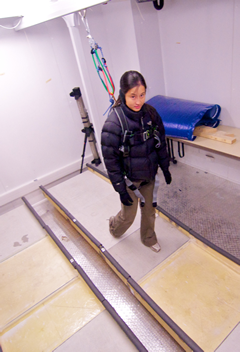The cold of a Canadian winter is bad enough, but it’s the fear of slipping on ice that keeps many elderly people indoors for much of the season. They know that falls can be deadly: 40 per cent of seniors who break a hip will die within a year.
Jennifer Hsu, a PhD student in the department of biomedical and mechanical engineering, wants to make winter walking safer for everyone, but especially for older people. She’s studying how people walk in treacherous cold-weather conditions and what sorts of devices might help them stay upright and in control.
Many companies market gadgets that you can attach to the soles of your winter boots to give you more traction. One uses rubber grips going in two directions (much like fish scales), while another employs gritty, sandpaper-like strips. In the first phase of her study, which began in October, Hsu invited 36 healthy people, aged 20 to 45, to test out the existing concepts in her cold lab – to see which work and which don’t. Later, she will study older healthy people.
Hsu’s lab is an insulated cold room in the Toronto Rehabilitation Institute with a slightly elevated walkway running from one side to the other. The walkway is made of concrete, but the researchers can coat it with patches of ice. “We want to see how body motion changes when moving on or off the ice,” says Hsu.
Sometimes there’s an incline, sometimes a decline and sometimes there’s a patch of ice. Luckily for participants, there’s always a harness to stop them before they hit the ground and a researcher in the room to help. Temperatures in the lab can go as low as -20 C.
Hsu and her team observe participants through a broad pane of glass. An array of sensors measures the subject’s muscle activity, the pressure distribution under each foot and how much pressure the person exerts on the ground. A set of cameras also tracks the motion of each foot. A computer then replicates each person’s movements so Hsu and her team can analyze them in detail.
Not all of the data will come from lab experiments. Cameras perched on the 12th floor of the Toronto Rehab building capture live winter footage of people slip-sliding through the intersection at University Avenue and Elm Street.
Eventually, Hsu would like to design truly “smart” footwear – with traction that responds to whatever conditions a person may encounter, and made from materials that can help improve our gait.
Recent Posts
For Greener Buildings, We Need to Rethink How We Construct Them
To meet its pledge to be carbon neutral by 2050, Canada needs to cut emissions from the construction industry. Architecture prof Kelly Doran has ideas
U of T’s 197th Birthday Quiz
Test your knowledge of all things U of T in honour of the university’s 197th anniversary on March 15!
Are Cold Plunges Good for You?
Research suggests they are, in three ways





